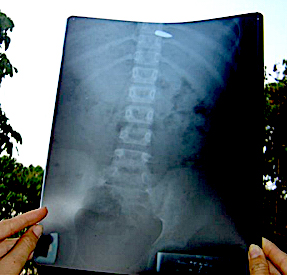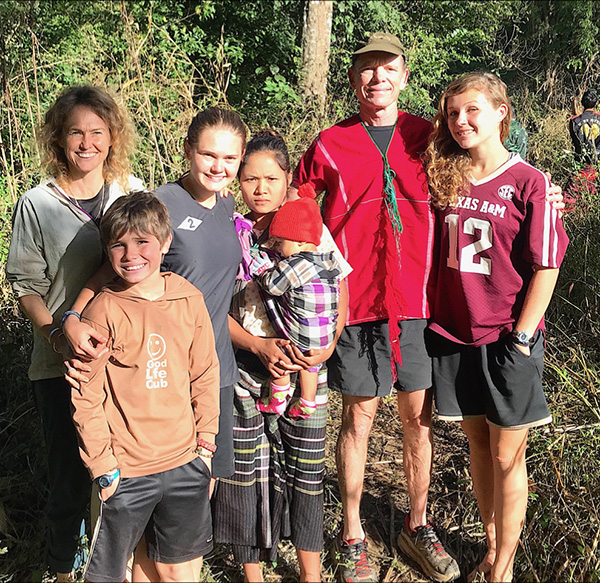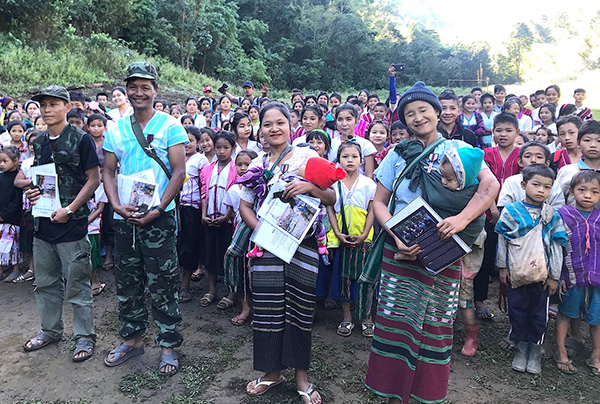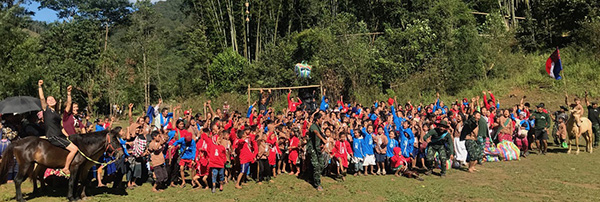“Do you remember me?” A Follow-Up Report on an 8-Year-Old Girl Shot by the Burma Army
14 February 2018
Ler Mu Plan, Karen State, Burma


“Shots rang out and I looked up to see Burma Army soldiers firing at us from the tree line about 30-40 yards away. Uncle Ray Bee Wah was hit many times and fell dead; my 15-year-old cousin Naw Ler Per’s arm was shattered by bullets; my brother, She Nay Htoo, was hit in the neck, and our friend, Saw Ti Tu, was shot too. I was shot in the stomach and fell down. The firing was intense and the Burma Army advanced. I was helped to my feet by the others and we ran for our lives. Bullets flew by us and we thought we would die but somehow we escaped. Just a few minutes earlier we had been working in our fields and now we were not sure we would survive. We kept running as the Burma Army continued shooting. We eventually escaped and that night walked to a hiding place. When we arrived we were taken care of by other villagers and our Karen Army medics. I was eight years old.”
It’s January 8, 2018, and Naw Moo Day Wah, a young Karen woman was recounting the Burma Army attack of October 30, 2002, in Ler Mu Plaw Village in northern Karen State. Troops under Captain Aung Khin of a Burma Army Light Infantry Battalion from the 101st Infantry had attacked villagers in Ler Mu Plaw, burning homes, killing one man, wounding another and wounding three children including herself. The Burma Army had driven the Karen people out of the Ler Mu Plaw area in 1997 but villagers like Naw Moo Day Wah would sneak back into the valley to gather crops that were still growing. This is a story of what happened and how we were brought together.

I had first heard her story in November 2002, two weeks after she was shot. I was home across the border and received a photo from one of the Karen medics who had treated Naw Moo Day Wah and the others. It was a picture of her, then an 8-year-old girl, lying unconscious on a bamboo mat. The note with the photo said, “Please pray for this girl, she is 8-years-old and was shot in the stomach by the Burma Army. She is in a coma and we are trying to keep her alive.” I looked at the photo of the little girl and felt a tightness in my chest and tears come to my eyes. I looked around, saw no one was in the house, and began to cry. I prayed God would save her somehow.
Just that morning I had met with some people who had tried to discourage us from going into Burma to help the Karen and others under attack. “It is illegal, we cannot help you if you get in trouble, the Karen resistance is armed and we don’t support that.” Earlier I had been told we were giving false hope to the ethnic people in Burma.
As I looked at the photo of Naw Moo Day Wah, those words came back to me in a rush and through my tears I said out loud, “This is why we go, it is for little girls like Naw Moo Day Wah and so many others who are hunted, shot, raped and killed by the Burma Army. We are very small but as long as God enables us, we will go to help people like her. I cannot look at a photo like this and do nothing.” I prayed God would heal Naw Moo Day Wah but felt hopeless. How could she survive the coma after being shot in the stomach, with no chance in the jungle for the complex surgery needed? I prayed for her and as I prepared for the next mission I felt very sad.

There were many areas under attack and it was over one month later before I arrived with our relief team into the area where Naw Moo Day Wah had been shot. I had not heard anything more about her and assumed she was dead. We were two weeks of walking from the border when we arrived at the collection of bamboo huts that served as a jungle clinic for the displaced near where she was from. I met the medic who had sent me the photo, thanked him for all he did and for sending the photo to me. I then asked him to show me where the grave of Naw Moo Day Wah was. “Grave? There is no grave, Naw Moo Day Wah is alive. She came out of the coma after eight days and with God’s help we nursed her to health. The bullet is still in her but she is alive. Do you want to see her?”
“Yes,” I said in wonder. In a few minutes Naw Moo Day Wah and her cousin, Naw Ler Per, who was shot at the same time, came up to us. I dropped to my knees and thanked God they were alive. I told them the story of how I had seen the picture and prayed but thought there was no hope. I thanked God and the medics and told Naw Moo Day Wah and Naw Ler Per that we would help any way we could. We coordinated with the medics and the girls’ families to bring them back across the border for treatment. A bullet was still inside Naw Moo Day Wah and Naw Ler Per’s arm needed surgery.
After the relief mission was complete we brought the two girls out with us. Naw Ler Per’s surgery was successful and she regained use of her arm but x-rays showed that the bullet that had hit Naw Moo Day Wah had gone through her liver and was lodged next to her spine. Any operation to try to remove it was too dangerous. We prayed with Naw Moo Day Wah and asked her how she felt. She said, “I am ok, the bullet doesn’t hurt too much, I will try.” We kept her at the hospital for another month to make sure she was ok and daily she got better. Finally she told us, “I do not feel the bullet very much anymore. Thank you. I am ready to go home. “
We took her back to her village on our next relief mission to that area and saw her sometimes on missions over the next six years. Then attacks increased in other areas and we did not see her again until this year. It was now 2018, just past the 20th anniversary of the Free Burma Rangers and 16 years since Naw Moo Day Wah and the others were shot. We were back with newly-trained relief teams in the same area and for the first time were going to the place Naw Moo Day Wah was shot. We went there because now many villagers who had been displaced were returning to their old homes. This was possible because of ceasefire talks between the Burma Army and the Karen. However the returning villagers were nervous and had repositioned their new homes behind a mountain out of sight of Burma Army camps on the ridges above. “We are trying to rebuild our homes after the Burma Army chased us out many years ago and burned our villages. We are not sure the ceasefire will turn out and there have been two attacks by the Burma Army already last month and this month. But this is our land and we will keep trying to rebuild our homes and pray that God keeps the Burma Army from attacking us.”
As our team began medical and dental treatment and a Good Life Club program for these people a woman carrying a child walked up to where we were camped beside a small stream. “Do you remember me?” she asked. “I am Naw Moo Day Wah, the little girl you helped. I am now married and this is my baby. Thank you for helping me and I am glad to see you. The bullet is still in me; it bothered me when I was giving birth to my baby but now it is ok.” My family and I gathered around her and we all celebrated the miracle of her life and new family. After a while her brother, Saw She Nay Htoo, and cousin, Naw Ler Per, came to see us and it was a happy reunion. All had healed from their wounds and Naw Ler Per was also married and had five children. Naw Moo Day Wah, speaking for all of them said, “This is our land, with God’s help we will stay. We need help but we want to stay.”


Later that day during the Good Life Club program for the families who had returned to this area we honored them and arranged more help for their families. “What a blessing,” I thought. “We got to see Naw Moo Day Wah again and now she has her own family and a hope for the future.” I thanked God and the Karen people that we got to be part of this and still are. This reminded me of the same feeling of completion I felt after we were reunited with Demoa, the little girl we rescued in Mosul last year. In the midst of hate, slaughter and destruction, here was life, love and hope.
Thank you for being in this with us.
God bless you,
Dave, family and teams


